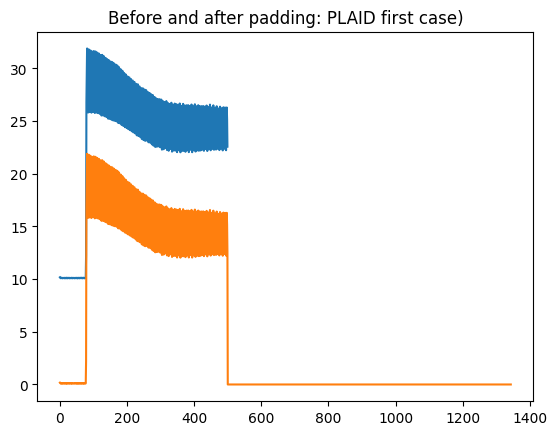Preprocessing data prior to machine learning¶
For machine learning, we assume that data is in shape (n_cases, n_channels, n_timepoints) for equal length series or a python list with len of [n_cases] if the series are unequal length. However, in reality, there are often many steps to get your data into this format. We introduce some common uses cases that may be handled with preprocessing, and give some suggestions about how to handle them.
[23]:
import numpy as np
from aeon.classification.distance_based import KNeighborsTimeSeriesClassifier
from aeon.datasets import load_japanese_vowels, load_plaid
from aeon.registry import all_estimators
from aeon.utils.validation import has_missing, is_equal_length, is_univariate
Missing values¶
Missing values are indicated by NaN in numpy array. You can test whether any aeon data structure contains missing values using the utility function
[26]:
X = np.random.random(size=(10, 2, 200))
has_missing(X)
[26]:
False
[27]:
X[5][0][55] = np.NAN
has_missing(X)
[27]:
True
There are a range of strategies for handling missing values. These include:
Use an estimator that internally handles missing values. It is fairly easy for some algorithms (such as decision trees) to internally deal with missing values, usually be using it as a distinct series value after discretisation.
Removing series with missing: this is often desirable if the train set size is large, the number of series with missing is small and the proportion of missing values for these series is high.
Interpolating: estimating the missing values from the other series values. This is often desirable if the train set size is small and the proportion of missing values is low.
Some forecasters can internally handle missing values, but there is very little support as yet for internally dealing with missing.
[29]:
all_estimators(
estimator_types=["classifier", "regressor", "clusterer", "forecaster"],
filter_tags={"capability:missing_values": True},
as_dataframe=True,
)
[29]:
| name | estimator | |
|---|---|---|
| 0 | ARIMA | <class 'aeon.forecasting.arima.ARIMA'> |
| 1 | AutoARIMA | <class 'aeon.forecasting.arima.AutoARIMA'> |
| 2 | AutoETS | <class 'aeon.forecasting.ets.AutoETS'> |
| 3 | DirRecTabularRegressionForecaster | <class 'aeon.forecasting.compose._reduce.DirRe... |
| 4 | DirRecTimeSeriesRegressionForecaster | <class 'aeon.forecasting.compose._reduce.DirRe... |
| 5 | DirectTabularRegressionForecaster | <class 'aeon.forecasting.compose._reduce.Direc... |
| 6 | DirectTimeSeriesRegressionForecaster | <class 'aeon.forecasting.compose._reduce.Direc... |
| 7 | DummyClassifier | <class 'aeon.classification._dummy.DummyClassi... |
| 8 | DummyRegressor | <class 'aeon.regression._dummy.DummyRegressor'> |
| 9 | DynamicFactor | <class 'aeon.forecasting.dynamic_factor.Dynami... |
| 10 | ForecastByLevel | <class 'aeon.forecasting.compose._grouped.Fore... |
| 11 | ForecastingPipeline | <class 'aeon.forecasting.compose._pipeline.For... |
| 12 | MultioutputTabularRegressionForecaster | <class 'aeon.forecasting.compose._reduce.Multi... |
| 13 | MultioutputTimeSeriesRegressionForecaster | <class 'aeon.forecasting.compose._reduce.Multi... |
| 14 | NaiveForecaster | <class 'aeon.forecasting.naive.NaiveForecaster'> |
| 15 | Permute | <class 'aeon.forecasting.compose._pipeline.Per... |
| 16 | RecursiveTabularRegressionForecaster | <class 'aeon.forecasting.compose._reduce.Recur... |
| 17 | RecursiveTimeSeriesRegressionForecaster | <class 'aeon.forecasting.compose._reduce.Recur... |
| 18 | SklearnRegressorPipeline | <class 'aeon.regression.compose._pipeline.Skle... |
| 19 | StackingForecaster | <class 'aeon.forecasting.compose._stack.Stacki... |
| 20 | TransformedTargetForecaster | <class 'aeon.forecasting.compose._pipeline.Tra... |
Removing series with missing and interpolation is currently best done by you: there are no transformers to deal with at at the moment. It is on the wish list.
Unequal length series¶
Learning from unequal length series is very common. aeon provided two baked in unequal length collections: the univariate PLAID dataset, and the multivariate JapaneseVowels dataset:
[13]:
plaid_X, plaid_y = load_plaid(split="train")
print(
f"PLAID is univariate = {is_univariate(plaid_X)} has missing ="
f"{has_missing(plaid_X)} is equal length = {is_equal_length(plaid_X)}"
)
vowels_X, vowels_y = load_japanese_vowels(split="train")
print(
f"JapaneseVowels is univariate = {is_univariate(vowels_X)} "
f"has missing = {has_missing(vowels_X)} is "
f"equal length = {is_equal_length(vowels_X)}"
)
PLAID is univariate = True has missing = False is equal length = False
JapaneseVowels is univariate = False has missing = False is equal length = False
Handling unequal length¶
There are two basic strategies for unequal length problems 1. Use an estimator that can internally handle missing values 2. Transform the data to be equal length by, for example, truncating or padding series
At the time of writing, functionality for handling unequal length series is limited. Estimators with the tag "capability:unequal_length": True have the capability to handle unequal length series. For classification, regression and clusterign, the current list is
[14]:
all_estimators(
estimator_types=["classifier", "regressor", "clusterer"],
filter_tags={"capability:unequal_length": True},
as_dataframe=True,
)
[14]:
| name | estimator | |
|---|---|---|
| 0 | Catch22Classifier | <class 'aeon.classification.feature_based._cat... |
| 1 | Catch22Regressor | <class 'aeon.regression.feature_based._catch22... |
| 2 | DummyClassifier | <class 'aeon.classification._dummy.DummyClassi... |
| 3 | ElasticEnsemble | <class 'aeon.classification.distance_based._el... |
| 4 | KNeighborsTimeSeriesClassifier | <class 'aeon.classification.distance_based._ti... |
| 5 | KNeighborsTimeSeriesRegressor | <class 'aeon.regression.distance_based._time_s... |
You can pass these estimators unequal length series and they will work as expected.
[15]:
knn = KNeighborsTimeSeriesClassifier()
knn.fit(plaid_X, plaid_y)
[15]:
KNeighborsTimeSeriesClassifier()In a Jupyter environment, please rerun this cell to show the HTML representation or trust the notebook.
On GitHub, the HTML representation is unable to render, please try loading this page with nbviewer.org.
KNeighborsTimeSeriesClassifier()
The alternative is to transform your data so that it becomes equal length, and can then be used with any time series estimator. Two simple examples are tpo pad the series to the longest series length, or to truncate to the shortest series length. By default, padding pads with zeros. Be careful if your data is not normalised, because this could then effect the classifier.
[17]:
from aeon.transformations.collection import PaddingTransformer
pt = PaddingTransformer()
plaid_equal = pt.fit_transform(plaid_X)
plaid_equal.shape
[17]:
(537, 1, 1344)
[21]:
import matplotlib.pyplot as plt
plt.title("Before and after padding: PLAID first case (shifted up for unpadded)")
plt.plot(plaid_X[0][0] + 10)
plt.plot(plaid_equal[0][0])
[21]:
[<matplotlib.lines.Line2D at 0x235ecdc37f0>]

Coming soon¶
Unequally spaced samples Streaming series: windowing and segmenting Channel selection for multivariate series Channel selection for multivariate series
Generated using nbsphinx. The Jupyter notebook can be found here.